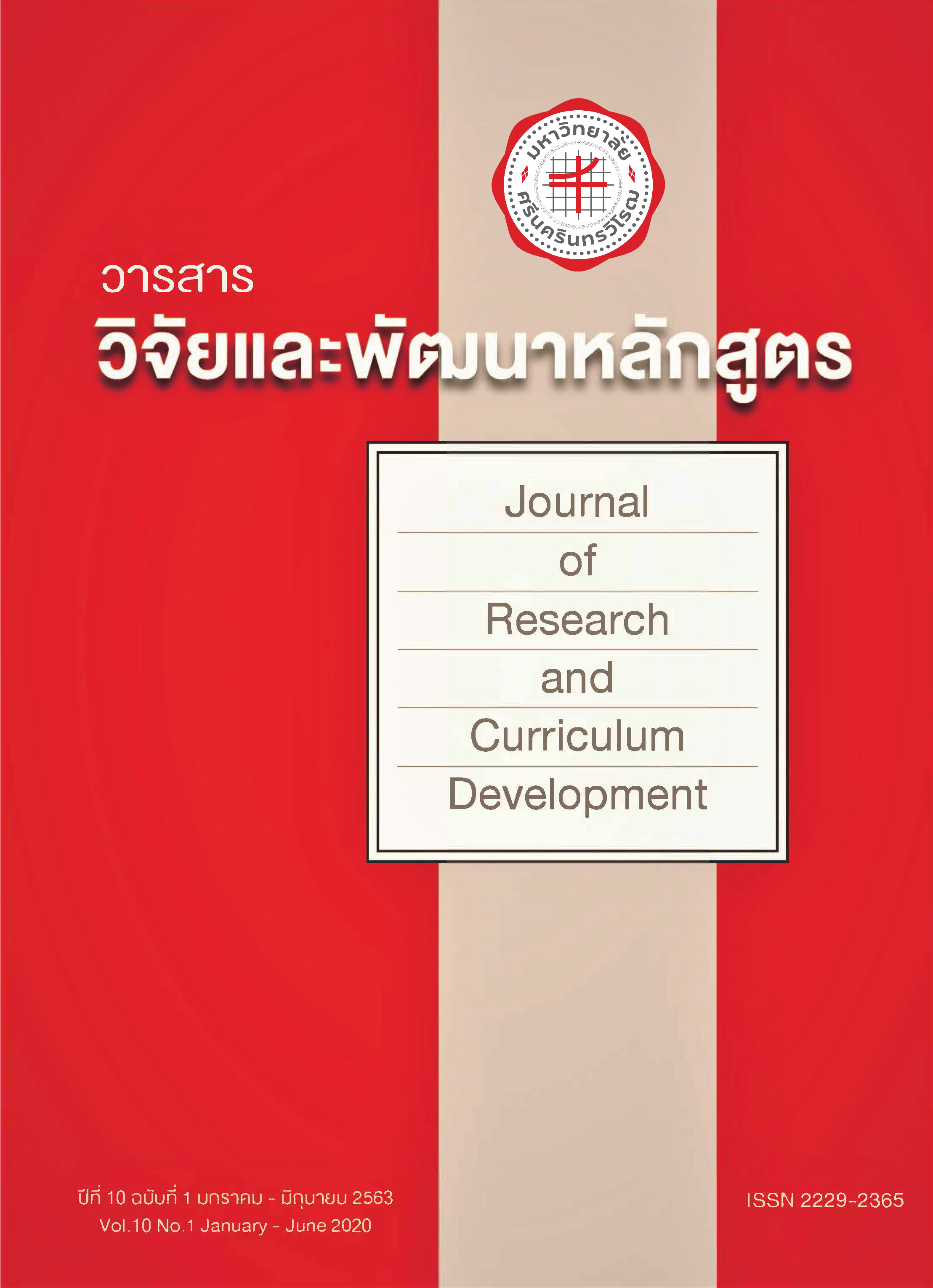การพัฒนารูปแบบการเสริมสร้างสมรรถนะความเป็นครูเชิงพุทธบูรณาการของนักศึกษาคณะครุศาสตร์ มหาวิทยาลัยราชภัฏ
Keywords:
model, teacher competency, the capacity of buddhist, Faculty of Education Rajabhat University,Abstract
The
research aim to 1) study the teacher competency status of the students in the faculty of education, Rajabhat university, 2) develop a model for enhancing competency of being an integrated Buddhist teacher of the student teachers in the faculty of education, Rajabhat university. The mixed research methods were use in the study. The qualitative Research by studying documents, in-depth interview with 5 administrator and instructors. Focus group discussions of 12 experts were used for validated the model. The model was experimented with 30 samples. The instruments used in this research were documentary study form, in-depth interview, evaluation of teacher competence. The quantitative research. A group of samples was selected from administrators and teachers in the faculty of education, Rajabhat University, 345 persons by multi – stage random sampling. The data were analyzed by content analysis, and statistical analysis. percentage, frequency, mean standard deviation and t-test dependent. The research results found that;
1. Teacher competency status of students in the faculty of education Rajabhat university is as follows 1) students lack the link between content and learning management methods, 2) students lack the spirit of being a teacher and professional teaching ethics,
3) students lack in volunteering, relations with parents, communities, and networking, 4) students are unable to organize learning that promotes thinking and 21st-century skills. The competency of the teacher that students should be strengthened to meet the standards of teachers there are 5 components, 1) The teacher must be knowledgeable, 2)Teachers need to proactively manage learning to develop students, 3) The teachers who acted as good, 4) Professional and professional development, 5) The teacher creates relationships with parents and communities.
2. The development of a model for improving the competency of being a Buddhist teacher in the integration from the students of the faculty of education, Rajabhat university consisted of 5 components; 1) Principle 2) Objective 3) Improving the competency of being a Buddhist teacher in the integration from the students 4) Application and 5) Achievement condition. By using in the model, it was found that the students had the competency of being an integrated Buddhist teacher. The mean value before the experiment was 10.87, the standard deviation was 1.51, the mean value after the experiment was 18.27, the standard deviation was 1.75. Showing that the teacher competency of students after the experiment using the integrated form of Buddhist teacher enhancement was higher than before the experiment by statistically significant at the .05 level.
References
ข้อบังคับคุรุสภาว่าด้วยมาตรฐานวิชาชีพ (ฉบับที่ 4) พ.ศ. 2562, (20 มีนาคม 2562). ราชกิจจานุเบกษา เล่ม 136ตอน68 ง. หน้า 2–3.
จุฑารัตน์ คชรัตน์และคณะ. (2561). สมรรถนะความเป็นครูมืออาชีพของนักศึกษาหลักสูตร ประกาศนียบัตรบัณฑิตวิชาชีพครู มหาวิทยาลัยหาดใหญ่. สงขลา: มหาวิทยาลัยหาดใหญ่.
ณัฐมน พันธุ์ชาตรี. (2559) การสร้างคุณลักษณะความเป็นครูของนักศึกษาคณะครุศาสตร์ มหาวิทยาลัยราชภัฏ (วิทยานิพนธ์ปรัชญาดุษฎีบัณฑิต สาขาวิชาการบริหารการศึกษา คณะศึกษาศาสตร์, มหาวิทยาลัยศิลปากร).
ถนอมพร เลาหจรัสแสง. (2561). การเรียนรู้ในยุคสมัยหน้า: ตอนอนาคตครูไทย ครูพันธุ์ C. [ออนไลน์]. แหล่งที่มา : http://sornorinno.blogspot.com/๒0๑0/0๙/c-c-teacher.html, 2561, [5มกราคม 2561].
ทัศนา ประสานตรี. (2555) การพัฒนารูปแบบความเป็นครูนักศึกษา มหาวิทยาลัยนครพนม, คณะศิลปศาสตร์และวิทยาศสตร์, มหาวิทยาลัยนครพนม.
นิทัศน์ หามนตรี. (2557). การนำเสนอแนวทางการพัฒนาสมรรถนะครู สังกัดสำนักงานเขตพื้นที่ การศึกษาปนะถมศึกษาพระนครศรีอยุธยาเขต 1. วิทยานิพนธ์ครุศาสตรมหาบัณฑิต สาขาวิชาการบริหารการศึกษา, มหาวิทยาลัยราชภัฏพระนครศรีอยุธยา.
บุญชม ศรีสะอาด. (2553). การวิจัยเบื้องต้น พิมพ์ครั้งที่ 5. กรุงเทพมหานคร: สุวีริยาสาส์นการ พิมพ์.
พระธรรมปิฎก (ป.อ. ปยุตฺโต). (2541). พุทธธรรม ฉบับเพิ่มเติมและขยายความ. พิมพ์ครั้งที่ ๑๑. กรุงเทพมหานคร: มูลนิธิพุทธธรรม.หน้า 603-604.
พระมหาเสกสรร จิรภาโส. (2552). การศึกษาวิเคราะห์หลักไตรสิกขาที่มีต่อการจัดการศึกษา ไทย . วิทยานิพนธ์มหาบัณฑิต สาขาวิชาพระพุทธศาสนา คณะครุศาสตร์, มหาวิทยาลัยมหาจุฬาลงกรณราชวิทยาลัย).
พระราชดำรัสสมเด็จพระเจ้าอยู่หัวมหาวชิราลงกรณบดินทรเทพยวรางกูรในโอกาสที่คณะครู
อาวุโสเข้าเฝ้าฯ รับพระราชทานเครื่องหมายเชิดชูเกียรติและเงินช่วยเหลือ ณ ศาลา
ดุสิดาลัยเมื่อวันที่ 13 มีนาคม พ.ศ. 2561
มารุต พัฒผล. (2557) สรุปรายงานการวิจัย เรื่อง การพัฒนารูปแบบการเสริมสร้างศักยภาพการ จัดการเรียนรู้ของครูโรงเรียนตำรวจตระเวนชายแดน. กรุงเทพฯ: บัณฑิตวิทยาลัย มหาวิทยาลัยศรีนครินทรวิโรฒ.
วิจารณ์ พานิช. (2555). วิถีสร้างการเรียนรู้เพื่อศิษย์ในศตวรรษที่ ๒๑. กรุงเทพฯ: มูลนิธิสดศรี- สฤษดิ์วงศ์.
สุกิจ โพธิ์ศิริกุล. (2554) การพัฒนาตัวบ่งชี้ความเป็นครูของนักศึกษาคณะครุศาสตร์ ( วิทยานิพนธ์ปรัชญาดุษฎีบัณฑิต สาขาวิชาการบริหารการศึกษา คณะศึกษาศาสตร์, มหาวิทยาลัยบูรพา).
สำนักงานราชบัณฑิตสภา. (2558). พจนานุกรมศัพท์ศึกษาศาสตร์ร่วมสมัย ฉบับราชบัณฑิตย สภา. กรุงเทพฯ: สำนักงานราชบัณฑิตสภา.
สำนักงานเลขาธิการสภาการศึกษา กระทรวงศึกษาธิการ. (2561). แผนการศึกษาแห่งชาติ พ.ศ. 2560 – 2579. กรุงเทพฯ: พริกหวานกราฟฟิค จำกัด.
อภิภา ปรัชญพฤทธิ์. (2561). การพัฒนารูปแบบการผลิตครูเพื่อรองรับการศึกษายุค 4.0. กรุงเทพฯ: จุฬาลงกรณ์มหาวิทยาลัย.
Comrey AL & Lee HB. (1992) A first course in factor analysis. (2nd Edition) New Jersy: Erlbaum.
McClelland, D.C.. (1975) A Competency model for human resource managementspecialists to be used in the delivery of the human resource management cycle. p. 3๒. Boston: Mcber.
Taro Yamane. (1973) Statistics: An Introductory Analysis.p. 727-728. Thirdeditio.Newyork: Harper and Row Publication.





